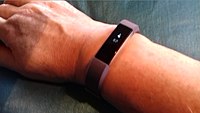
Photo from wikipedia
Purpose Commercial wearable sleep-tracking devices are growing in popularity and in recent studies have performed well against gold standard sleep measurement techniques. However, most studies were conducted in controlled laboratory… Click to show full abstract
Purpose Commercial wearable sleep-tracking devices are growing in popularity and in recent studies have performed well against gold standard sleep measurement techniques. However, most studies were conducted in controlled laboratory conditions. We therefore aimed to test the performance of devices under naturalistic unrestricted home sleep conditions. Participants and Methods Healthy young adults (n = 21; 12 women, 9 men; 29.0 ± 5.0 years, mean ± SD) slept at home under unrestricted conditions for 1 week using a set of commercial wearable sleep-tracking devices and completed daily sleep diaries. Devices included the Fatigue Science Readiband, Fitbit Inspire HR, Oura ring, and Polar Vantage V Titan. Participants also wore a research-grade actigraphy watch (Philips Respironics Actiwatch 2) for comparison. To assess performance, all devices were compared with a high performing mobile sleep electroencephalography headband device (Dreem 2). Analyses included epoch-by-epoch and sleep summary agreement comparisons. Results Devices accurately tracked sleep-wake summary metrics (ie, time in bed, total sleep time, sleep efficiency, sleep latency, wake after sleep onset) on most nights but performed best on nights with higher sleep efficiency. Epoch-by-epoch sensitivity (for sleep) and specificity (for wake), respectively, were as follows: Actiwatch (0.95, 0.35), Fatigue Science (0.94, 0.40), Fitbit (0.93, 0.45), Oura (0.94, 0.41), and Polar (0.96, 0.35). Sleep stage-tracking performance was mixed, with high variability. Conclusion As in previous studies, all devices were better at detecting sleep than wake, and most devices compared favorably to actigraphy in wake detection. Devices performed best on nights with more consolidated sleep patterns. Unrestricted sleep TIB differences were accurately tracked on most nights. High variability in sleep stage-tracking performance suggests that these devices, in their current form, are still best utilized for tracking sleep-wake outcomes and not sleep stages. Most commercial wearables exhibited promising performance for tracking sleep-wake in real-world conditions, further supporting their consideration as an alternative to actigraphy.
Journal Title: Nature and Science of Sleep
Year Published: 2022
Link to full text (if available)
Share on Social Media: Sign Up to like & get
recommendations!